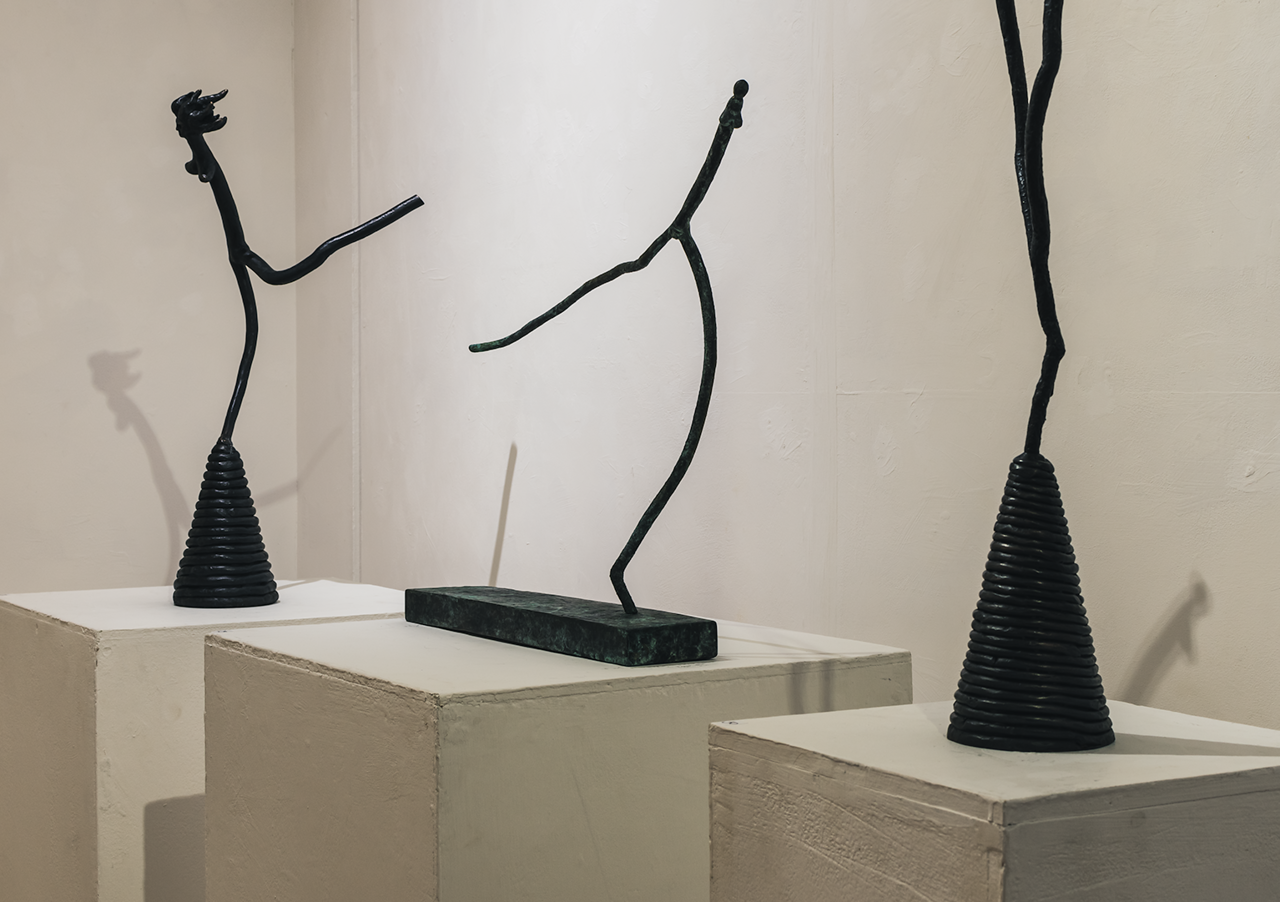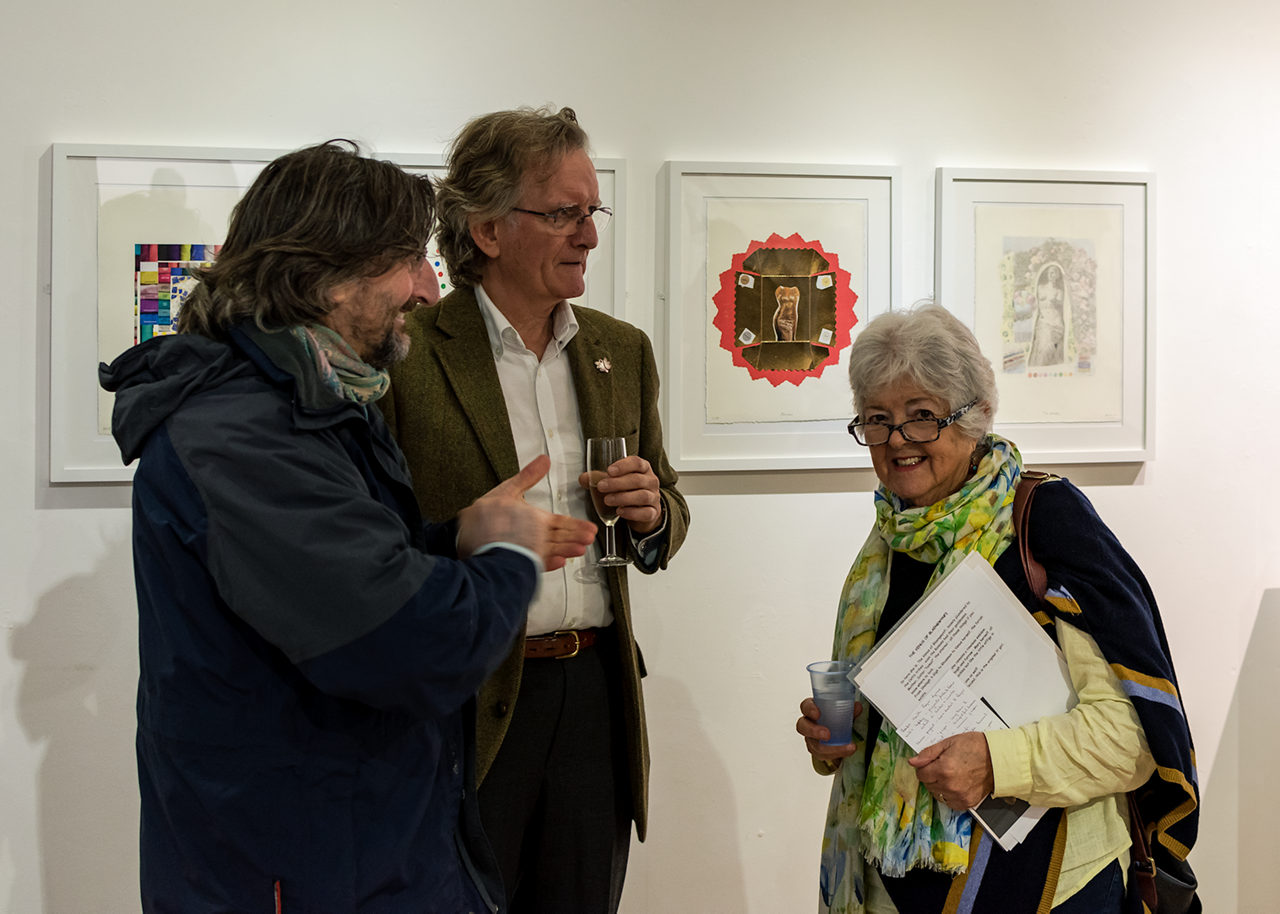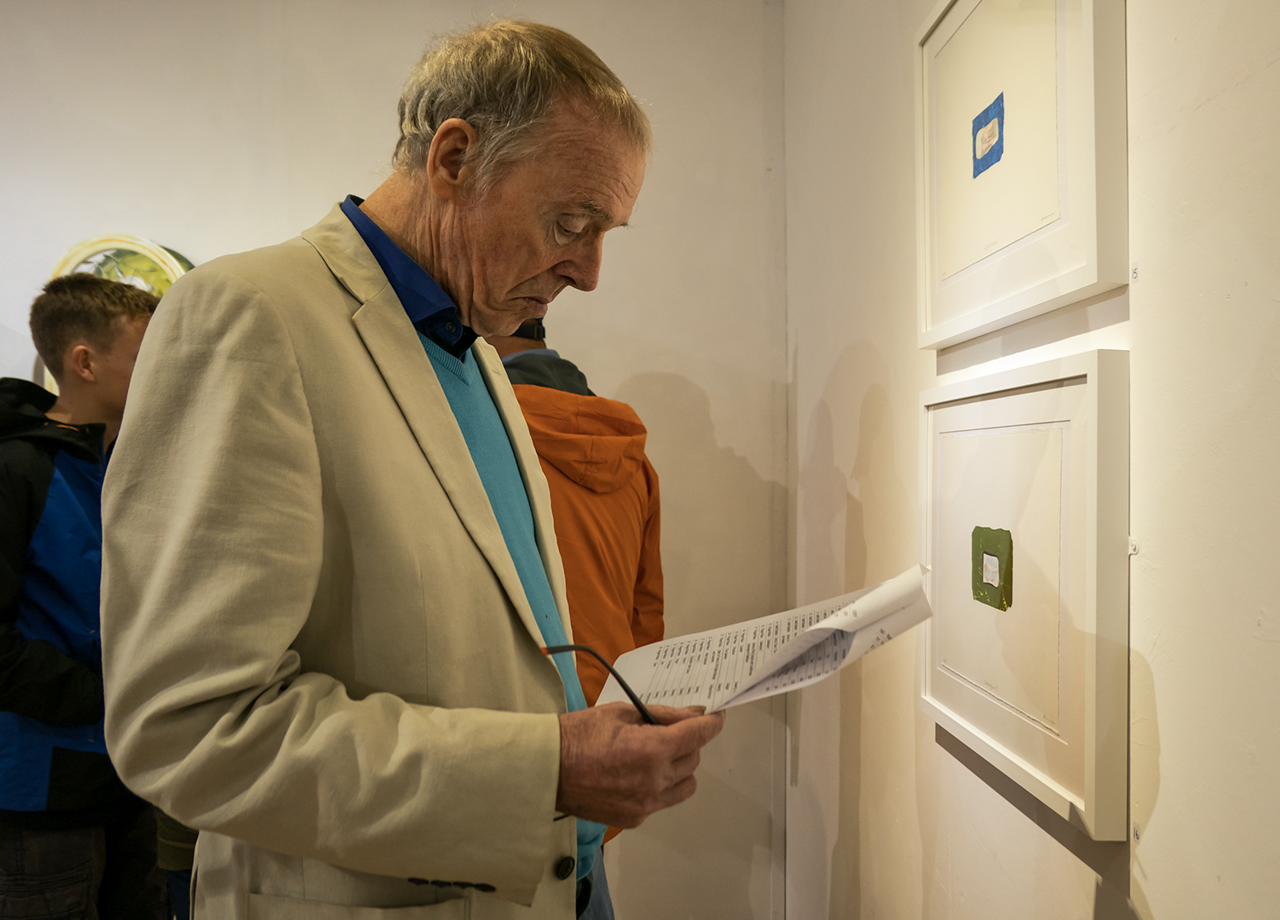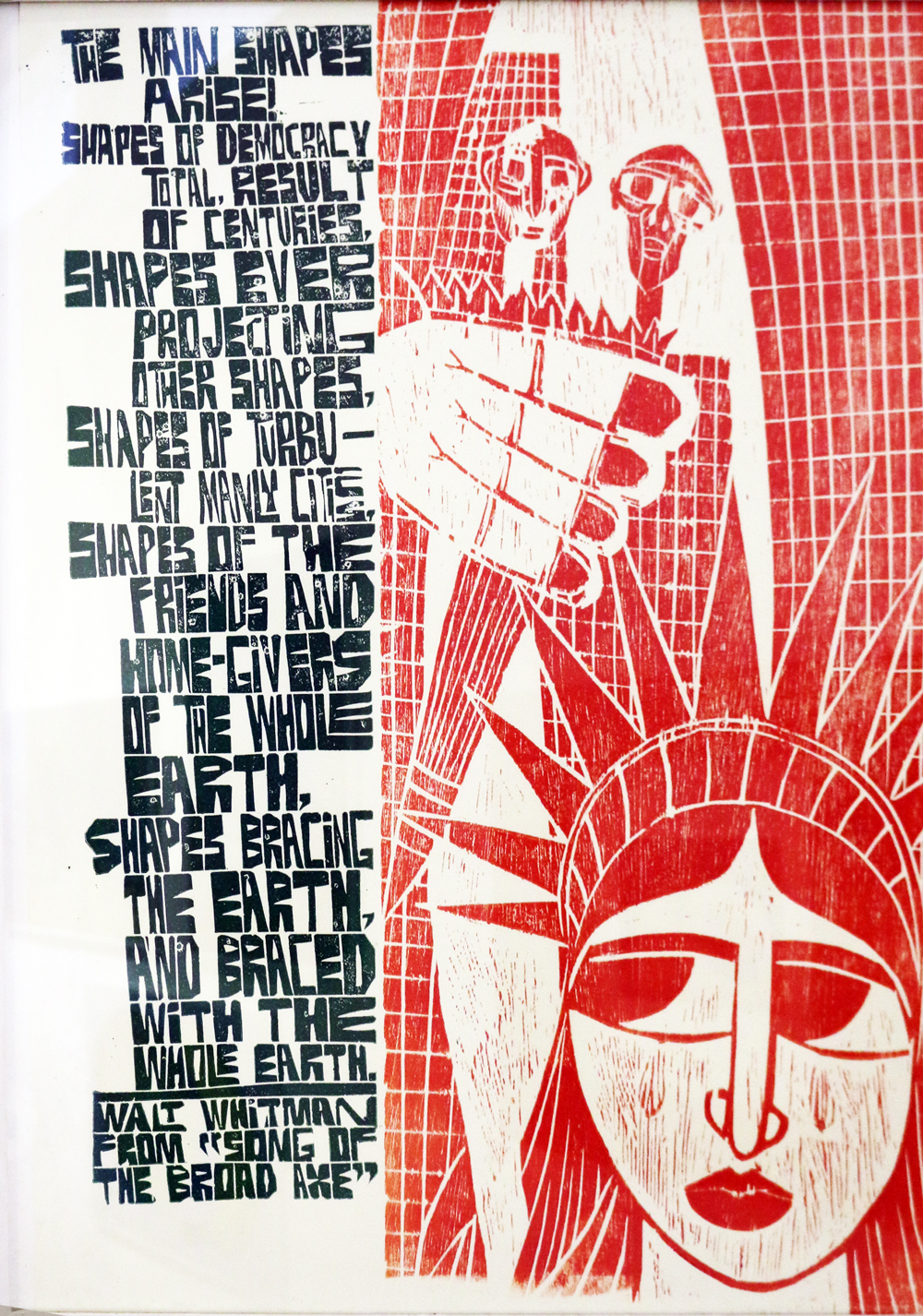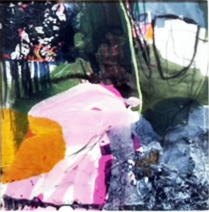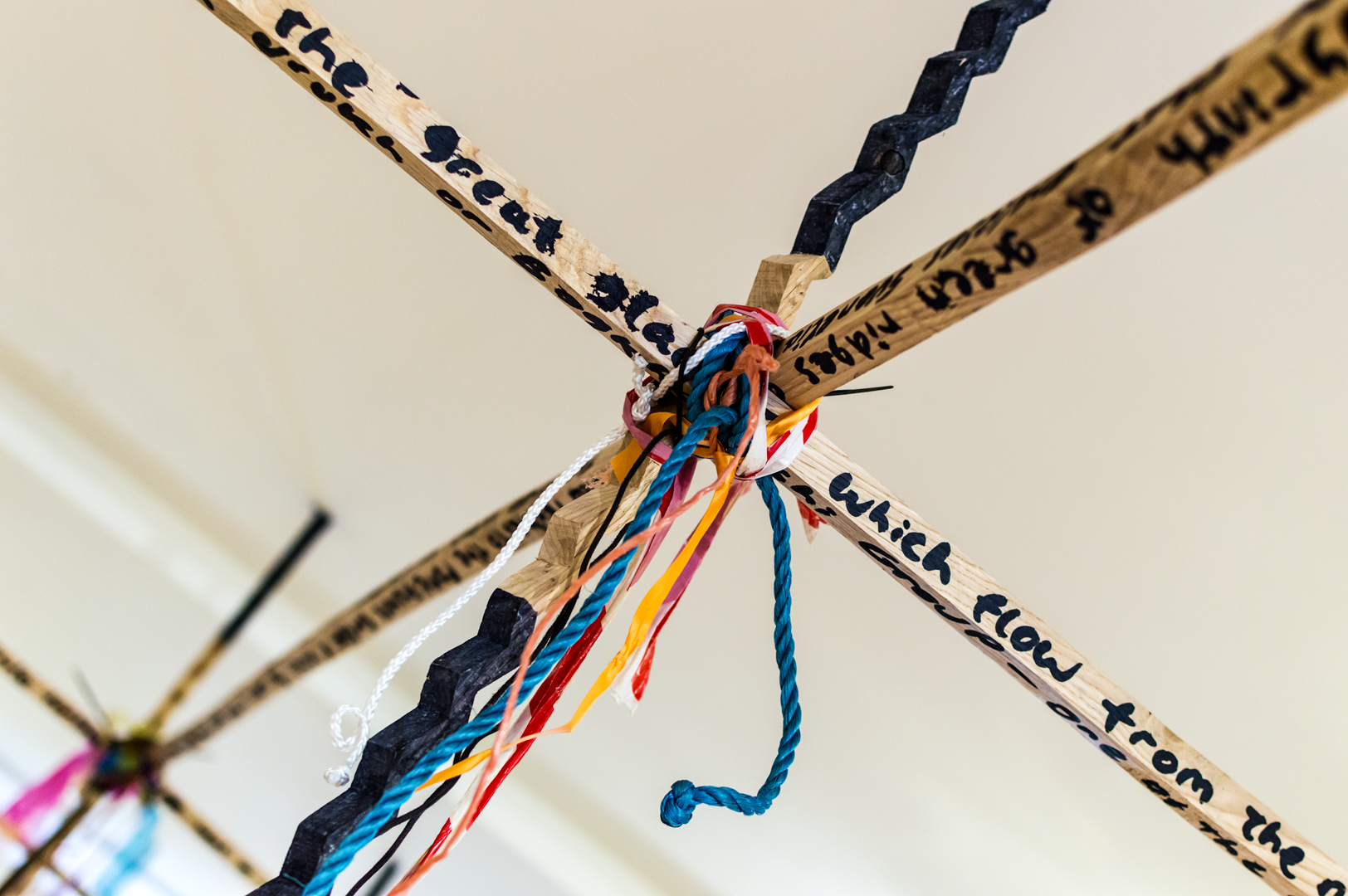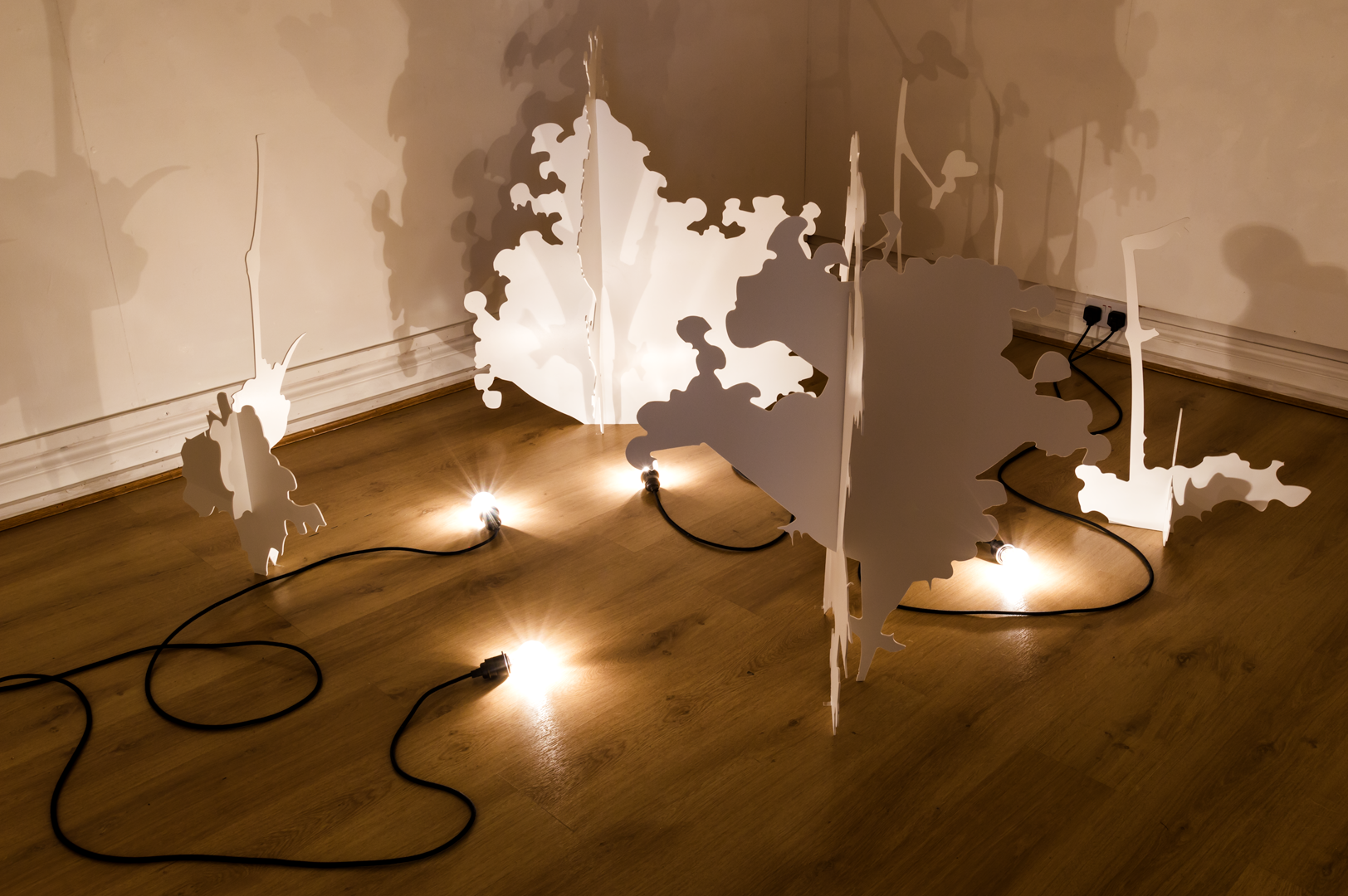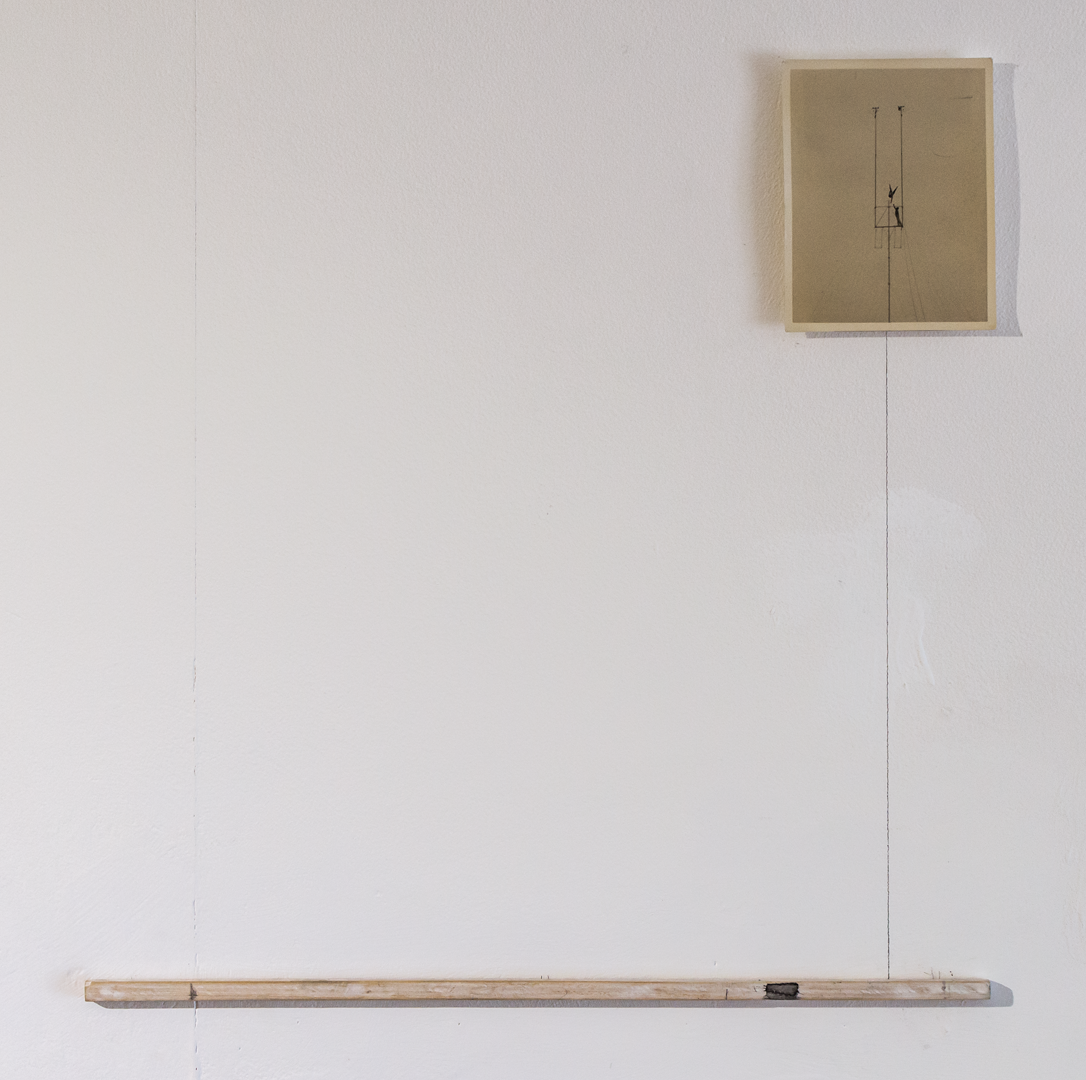Many thanks to David for reading his poem as part of the In Conversation With: Keith Bayliss and Roger Moss event. Click this post to read the poem in full.
Eamon Colman has generously donated his painting, ‘Dreaming in exile of a lonely field’ from his recent exhibition here at the gallery (click HERE for exhibition info) in a bid to help us raise funds. We cannot thank Eamon enough! We will be selling raffle tickets to win this original artwork. Tickets are £10 each, the raffle will be drawn on the last day of the Winter Open exhibition 2018 (December 23rd) and the winner will be notified before Christmas.
This is an excellent opportunity to obtain an original piece of work from an internationally recognised and established artist, whilst also supporting Oriel Q Gallery.
Raffle tickets to win this brilliant prize are available from Oriel Q Gallery in Narberth. Find us on the top floor of the Queens Hall. If you are unable to get to the gallery, we can arrange tickets via email - please contact us on info@orielqnarberth.com
Do not miss out on this fantastic opportunity and good luck!
Below is a full-view of the painting to be won…
Eamon Colman ‘Dreaming in exile of a lonely field’
Mixed Media £2600
Oriel Q: Open Call...
We are very excited to announce that the annual Winter Open Exhibition returns for 2018 and we would like to extend an invite to all professional, amateur and student artists to submit work in any media and subject for consideration.
Hand-in days are 9-10 November 2018 between 11am and 4pm.
Up to 3 works can be submitted, 2D work must be mirror-plated for insurance purposes; an entry form for each piece must be completed and a high quality digital image must be provided for the digital catalogue and website.
There is a £5 fee per entry, which will be waived if you are a current member of the Friends of Oriel Q. Entry forms are available at Oriel Q or to download below.
The Winter Open Exhibition will then open on Saturday 17th November 2018 at 2pm, refreshments will be available, all very welcome
Winter Exhibition RAFFLE...
The Friends of Oriel Q Committee are bringing back the Christmas Art Raffle for another year following the great success in 2017 but we cannot do it without the generosity of our supporters.
In the Gallery, we have a number of small blank canvases and we are asking artists and friends to take a canvas and create a piece of work that they are happy to donate as a raffle prize. Raffle tickets will be sold for £2 a tickets (Books for £10) with all proceeds going towards Oriel Q. The Raffle will be drawn on the Saturday 22nd December 2017 and we will also be throwing a bit of an Xmas Do - come join us for a mince pie!
If you would like to donate a piece of work to the Raffle, canvases are available from Oriel Q (if needed), once again any medium and content is welcome. We thank you in advance for your support.
Image used: Painting by Julie Gannon 2018
22nd September 2018 saw the opening of the much-anticipated exhibition VENUS, a collaborative effort between Keith Bayliss, Roger Moss and the late William Brown.
We are very grateful to Carys Brown, who was present to open the exhibition. Below are some images from the opening, many thanks to David Street for these fabulous images. .
From left to right; Keith Bayliss, Carys Brown, Lynne Crompton, Roger Moss
Leigh Sinclair delivered a day of painting, printing and collage to a full house of eager learners on Saturday 8th September 2018. Leigh showed the class his signature technique of a paint/print combo to great effect with every attendee producing something they were proud of.
Each attendee was very pleased with the workshop, the new technique they were learning and their creative outcomes. Comments included;
“Very enjoyable, I’ve learned a lot… I’ve had a lot of fun”
“A really dun and Energising workshop”
“Great! All of it”
Friday 3rd August saw Eamon Colman return to Oriel Q Gallery, Narberth to open his new exhibition 'THAW'. This show has been highly anticipated and did not disappoint. Below are some images of the Opening; many thanks to David Street for documenting the evening.
Please click HERE for more information on Eamon's current exhibition at Oriel Q; HERE for details on his forthcoming talk at Oriel Q on 15th September 2018.
Eamon Colman stands in front of 'The Poet's House'
Groups of attendees gather to discuss the work
Contemplating the piece, 'Autocumulus clouds blow dreaming to alititude'
Lynne Crompton and Eamon Colman in conversation
Reflecting on 'The Poet's House'
Eamon Colman's exhibition is open until September 15th 2018 and will culminate in a talk delivered by Eamon himself. Join us here at Oriel Q at 2pm; all are very welcome and refreshments will be available
Exhibiting alongside Eamon Colman is Leigh Sinclair with his bold semi-abstract print paintings which play around with allegory, pattern line & colour. Please click HERE for more info.
Georgina Hughes is also exhibiting her photographic series 'Memento Mori' on The Stairs here at Oriel Q, her photographs playing close attention to the detail and exquisite beauty in the minutiae along with personal significance within objects. please click HERE for further details.
The Poet’s House
To a nonpainter, oil paint is uninteresting and faintly unpleasant. To a painter, it is the life’s blood: a substance so utterly entrancing, infuriating, and ravishingly beautiful that it makes it worthwhile to go back into the studio every morning, year after year, for an entire lifetime.[1] - James Elkins 'What Painting Is'
Preface
For Eamon Colman, each painting is a new conversation between the processes of painting and a complex, remembered, and inclusive sense of a place. My encounter with his work has also been a conversation, unpredictable, surprising and often humbling. I have not written about art as art for many years and my interest lies in its “broader implications… as an epistemology … a way to understand one’s relationship to what lies beyond it.”[2] In its being a place one enters alone, “but in communion with your imagination… solitudes in which we meet”.[3]
I initially assumed my task here was to pay close attention to the conversation that unfolded with the work and then to write a text. There was, however, a complication. After a life working in academia, discovering Colman’s work upped the challenge to think and write differently. A challenge that, in the last eighteen months, has become closely related to my return to painting. So, I write here as a late returnee, one wishing to look again at the complex relationship between painting and place.
Eamon Colman 'The Poet's House'
Storied land
"We tell ourselves stories in order to live...[4] // I think of human psyches as landscapes…"[5] - Rebecca Solnit
I knew virtually nothing of Eamon Colman’s work until I saw paintings from his Scattered Showers exhibition. Initially intrigued as much by his knowledge of the history and qualities of the County Kilkenny uplands as by his work, I nevertheless began to look carefully at the paintings. My curiosity stemmed from our being creatively immersed in similar landscapes, engrossed by the particularities, challenges and environment of upland regions, their weather, their specific inflections of human community.
Recently, visiting Colman’s studio, I carried some of his earlier paintings in my mind’s eye. These provided a bridge between his way of showing how the spaces of the world feel and my own internal store of valued paintings. 'Dreaming in exile of a lonely field' pushes identification as landscape to its limit. With time, however, its freely worked interlocked spaces - their densities and transparences, horizontal brush-strokes, textures and clusters of marks – form distinct yet conjoined fields resonant of land first walked, then re-membered through the act of painting. (The speckling of small cross-like marks, I now know, recall an encounter with a departing murmuration of starlings). Working my way out from a specific painter’s strategy, the play between spaces paired and contrasted, that is masterfully deployed in both Sassetta’s The Wolf of Gubbio and Peter de Hooch’s Courtyard of a House in Delft, I discovered a clear formal kinship with Colman’s painting. That kinship provided an initial portal into his work.
The process of painting land, first walked and then remembered, created 'Dreaming in exile of a lonely field', but it remained incomplete until given its title. The title reverberated, at least for me, with Liam Carson’s 'Call Mother a Lonely Field', an emotional archaeology of family, home and language, and of Jackie Levan’s haunting song of the same name. These resonances amplified my response to the work, suggesting a common emotional heft in relation to land, and reminding me that Colman has a wide knowledge and deep appreciation of poetry. (This exhibition shares a title with Paula Meehan’s poem The Thaw, in the collection Geomantic).[6]Also, that he draws on collective, as much as personal, memory in the work. What remains in the foreground, however, is a painting wrought from coloured matter, from the pull and push of painted spaces that conjoin, in paint as in memory, a sense of the shifting sense of materiality experienced when walking a place.
I was puzzled that Colman is simply referred to as a landscape painter. Then I learned that he’d described himself as “fundamentally … a storyteller”, as influenced by “listening to other people’s stories and interpreting their dreams”.[7] This provided another bridge into the work, linking his approach to that of deep mapping. It confirmed the importance of place as narrative, as “a simultaneity of ‘stories-so-far”,[8] articulated in images made by interweaving different processes, seen as stories, moving through time.
Discussing the walks that prompted many recent paintings, I came to see that one work may reference both a distant historical act that violently reshaped a landscape – say a hill built to enable artillery to better attack a castle - and subsequent slow modifications, over centuries, to that same hill. Various paintings in the exhibition suggest such a convergence of distinct temporalities, both those related to Oliver’s Hill (the reference is to Cromwell), but also to the Bog of Diamonds, so called because of a local inability to pronounce its long-dead Dutch owner’s name (and despite at least one terrible episode in its history). I began to see how Colman’s embodied thinking, working with colour, gesture and, increasingly, varieties of texture and surface, relates to the dynamic of place conceived as storied material, as a play of unfolding matterings over time.
Place as ‘vibrant matter’
Paint can move us, stir our senses and memory through colour and tone, carry traces of life’s rhythms through the dance, precise or wild, of a brush. Its texture, viscosity, ability to hold bodily gesture in the weight and direction of a mark will, if we open to it, animate felt meaning. Unsurprisingly, in a critical culture that over-privileges concept and fears ‘the thought of the heart’, the vast literature on painting has almost nothing to say about paint’s material discourse. One rare exception, written by the painter-turned-art-historian James Elkins, uses alchemy as “an encounter with the substances in the world around us”, to suggest “how paint can mean”.[9]However, his approach seems too rarefied to speak to the weathered earthiness of Colman’s recent work.
By contrast, Jane Bennett’s Vibrant Matter, more worldly and inclusive, encourages us to engage expansively “with vibrant matter and lively things”, to dissipate binaries such as “life/matter…and organic/inorganic”, arguing for: “an aesthetic-affective openness to material vitality.”[10] This seems to me comes closer to Colman’s concerns. It also invites me to read his paintings as animating a spectrum of matter(s)-that-matter. An enacting of ways of ‘being in’, rather than ‘looking at’, a landscape, encouraging me to sidestep the strict conceptual distinctions between time and space, nature and culture. There is a cliché that the secret to landscape painting is ‘knowing where to sit down’. Colman doesn’t sit still, nor pin down the appearance of a place from a single, static viewpoint. Instead he walks, attending with every sense, moving within the multiverse of contingent and changing worlds, internal and external, that surround and embrace him.
In all this there is a challenge to the assumption that matter is inert, dead. The pernicious assumption that feeds our culture’s hubris, its toxic fantasies of conquest and consumption. Fuels our violent disregard for the intricate and lively reciprocities proper to the life of a regional watershed in relation to a river, a river to an old wood, an old wood to a tump of sphagnum moss. Colman’s paintings remind me that the places of the world, distinct yet endlessly implicated in rich meshes of connectivity, are animate. They exist not just in the immediate here and now, but extend a complex past towards a potential, living, future. Or, as Colman has put it: “the earth is a living being like you or I … it’s an organism that breaths and communicates”.[11]
A change in the weather
Increasing dramatic climatic swings between heat and cold are becoming normal. The recent winter and spring in upland regions across both Ireland and the UK was extreme, with deep snow in many places and the thaw, when it arrived, was often slow, messy, and late.
Many of the paintings Eamon Colman has made recently hint at personal, social and environmental change. The sense of strong, high key colour still foremost in his 2015 exhibition, Walking at three miles an hour has become more muted, and in many works now seems subordinate to a concern with surface. Over that period, the highlands of County Kilkenny, where he lives, works and walks, have seen worsening weather, something he has verified for himself by logging the decrease in sunny days.
Climate change is inscribing itself onto the already battered and weather-worn uplands across the western islands of Europe, rendering them more ragged, drearier, wetter for longer periods each year. The human hold on such regions, which for long historical periods has been somewhat clumsy and tenuous, may once again be slowly slipping away. They are now all-too-often raw, grey or white with mist, soggy from days or weeks of incessant rain, torn into both by violent storms and the whole spectrum of agricultural and other human intervention. Something of this is echoed in those recent paintings where surfaces, by turns raw, fragile, slippery, textured by the traces of stain and run-off, aggravated by re-working, come increasingly to the fore.
The airy qualities of The white edge of silent light, The astonishing art of the cold snap, or After dawn rain the wind came to lift everything, their sense of wide skies and movement, are largely gone. The more recent work seems bleaker, earthier, increasingly marked out by passages of black, blue-black, grays, whites and off-whites and, above all, by their infinitely variegated surfaces. Surfaces roughly laid down, cobbled together, then tattered, scoured, pressed into or worn flat, by the process of their own making. Surfaces distinguished, in turn, by being weathered, washed, compressed, lifted, worn smooth, stained, torn, runnelled and eroded by intense, almost heedless, acts of making, unmaking, remaking.
They suggest harsh, rapid, changes; a life world patched up, dug down into, stripped back, exposed. They have both an air of foreboding and of the ancient peasant ability to ‘make do’, ‘get by’. Not, however, in response to official exhortations to greater resilience, but simply because there is no alternative. A feeling too of grim anticipation. During one conversation, Colman told me he senses a growing challenge from the natural world; its telling us to: “either piss or get off the pot”.
The Poet’s House
"Where does a story begin? The fiction is that they do, and end, rather than that the stuff of a story is just a cup of water scooped from the sea and poured back into it …"[12] - Rebecca Solnit
At this point I have no option but to join the company of outliers, those who turn to subjugated, superseded, suppressed, marginal or ignored knowledges. No option because the underlying presuppositions of Western thought are too narrow to allow me to draw out the most significant resonances of The Poet’s House. I need a more inclusive, nuanced orientation to bypass the assumptions of a world predicated on the ‘either/or’ inherent in our monotheistic tradition and its continuation by other, secular, means.
Taoist philosophy is helpful here in distinguishing between ethereal (Hun) and corporeal (Po) souls. (In this context After dawn rain the wind came to lift everything enacts something of the qualities of the Hun-soul). Broadly speaking, the Po-soul is understood as linked to sensory perceptions, to a tangible, embodied consciousness inseparable from sight, sound, smell, taste and touch. To that aspect of human consciousness that, in obedience to over-arching ecological imperatives, dissolves back into the earth with the body at the time of death. But also, by implication, the soul that, perhaps paradoxically, underwrites embodiment and, consequently, makes the creative arts possible. The soul that also represents our primal or animal instincts and our ability to receive what is of essential worth, enabling us to let go of what no longer nourishes us. A sense of soul, then, appropriate to a re-articulation of the ecological dilemmas we face.
I experience The Poet’s House as a nuanced, layered and highly particular meditation on the Po-soul.
At a personal level I sense this painting’s relationship to Colman’s recent painful illness and slow recovery (the occasion that prompted many of the small works here). Such illnesses strip us back, both deepen our sense of mortality and of the ‘worlding’ of the world we inhabit. They leave us both thinner-skinned regarding the unexpected beauty of everyday phenomena and more ‘dug into’ the necessary in our lives. At a social level, I see the painting as reflecting on the value, and inevitable fragility, of friendship in the face of death. Finally, at the ecological level, I sense it speaking to our need to more openly acknowledge the endless dissolutions and transformations facing all matter, ourselves included. Transformations without any redemption for human beings, beyond our facing what simply is, in all its richness and complexity, both on our own behalf and that of all non-human beings, our kith and kin.
The Poet’s House is perhaps unique in Colman’s work in including a clearly articulated figure. A small bent figure, almost black, placed centre stage in the lower part of the painting. While ghosts and traces of figures have previously appeared in a very few other paintings, including Meabh’s tree on the hill of pain, none are as emphatically present as this. (Colman renounced the figure, along with its overwhelming primacy in western art, at the start of his career. When questioned about the rare exceptions, he simply observed that, in Ireland, “our ghosts are very near”). Paradoxically, while emphatically present, the figure also appears as if being erased by the very earth it cultivates. She appears - the painting was occasioned by the death of the poet Leland Bardwell, aged ninety-four - as her own Po-soul, cultivating the earth even as she returns to it.
Leland Bardwell’s The Noise of Masonry Settling contains her Four Woodbines, with its opening line that marks “the torn and dirty sheets” of “winter years”[13] and, in doing so, seems to speak directly to the genesis of many of the works in this exhibition. The Poet’s House is, I would suggest, one key to the heft of the whole sequence of Thaw paintings, large and small.
We can never say, definitively, what such a painting ‘means’ or ‘is about’. Such works are an invitation, not a statement of fact or intent. What, then, am I to write of the small stained house grounded in, and fading back into, a roughly assembled, dissolving black landscape? (And do these blacks reference those enumerated in Bardwell’s Black in Achill?) Or of the slab of pink resonant of a child’s painting of skin, a pink that here fades into a blue-black that hints of old blood in a vein under the papery skin of old age? Or of that slab’s relationship to the small black figure herself, dissolving back into a pool of blue, of memory? What sense is evoked by the upheaval, be it of thaw or glacial dissolution, projected by the various weights and thicknesses of the slippery white paint strokes that dominates the centre and the right side of the painting before, as I see it, tumbling down into the sea below?
Whatever responses these and other questions may prompt, they will be inflected by our openness to the metaphorical resonances, within the painting, of its title. Colman spoke movingly to me of Leland Bardwell’s last days in her cottage on the coast of County Sligo. Also of her poem, A Single Rose, which appeared with several of her obituaries, a poem in which her brain has transmuted into “a single rose”. (This is the source, I suggest, of the red, rose-like form that emerges, far top right, from behind the swath of black that threatens to hide it). But the painting, for all its questions and sense of polarized and elemental forces, and of the dissolving of the poet as Po-soul, will ultimately remain a vivid confluence of senses that always escape the precision of meaning we ask of prose.
There comes a point for us to stop, to go back to simple noticing. After all, revelation, as James Hillman writes:
"… is always going on in display. It requires no literal witness, no special prophetic gift, only exegetical intelligence, that ability to read display, to notice beauty. No testimony, only a careful noticing, a considerate appreciation of “eachness” (Wm. James), each thing in its image, each word in its echo."[14]
Iain Biggs, Bristol, UK, May 2018
Notes
[1] James Elkins (2000) What Painting Is: How to Think about Oil Painting, using the Language of Alchemy New York: Routledge p. 4.
[2] Suzanne Hudson ‘Personal Voyages’ in Lynne Cooke (ed.) (2018) Outliers and American Vanguard Art Chicago, University of Chicago Press p. 118.
[3] Rebecca Solnit (2014) The Faraway Nearby London: Granta p. 54.
[4] Ibid. p. 3.
[5] Ibid. p. 25.
[6] Paula Meehan (2016) Geomantic Dublin: The Dedalus Press p. 75. (Eamon Colman could not know the resonances this poem would have for me, given my long-standing preoccupation with wolves, but such are the strange coincidences, if indeed that’s what they are, that haunt the places to which poetry takes us).
[7] See Nigel Rolfe (2006) ‘A Conversation with the Artist’ in Profile 25: Eamon Coleman Oysterhaven, Co Cork: Gandon Editions pp. 13 and 17.
[8] Doreen Massey (2005) For Space London: SAGE Publications p. 9.
[9] James Elkins op. cit. pp. 6-7.
[10] Jane Bennett (2010) Vibrant Matter: a political ecology of things Durham & London: Duke University Press pp. viii and x.
[11] Eamon Colman in conversation with Brian McAvera (2007) ‘Between Landscape and Abstraction’ in Irish Arts Review Spring 2007 p. 67. http://www.eamoncolman.com/wp-content/uploads/2016/05/Irish-Arts-Review_Feature-copy.pdf (downloaded 03.03.2018).
[12] Rebecca Solnit op.cit. p. 27.
[13] Four Woodbines in Leland Bardwell (2006) The noise of masonry settling Dublin, The Dedalus Press p. 57.
[14] James Hillman (1986) On Paranoia Dallas, Texas: Spring Publications, Inc p. 45.
The Summer Open Auction 2018 was a great success here at Oriel Q gallery, Narberth with over £5500 of art sold…
23 Years of the Summer Art Auction 2018
Come join us here at Oriel Q Narberth on Sunday 29th July at 2pm for our annual Art Auction (more info below on its 23 year history!). Opened on Saturday 23rd June, the Show has attracted much praise for the high standard of work, and offers a fantastic opportunity to purchase art at very affordable prices - If you cannot make it, click HERE for an illustrated digital catalogue.
Sealed bids may be left in person and now via email! HERE is the digital sealed bid form; please fill in and email back to us on info@orielqnarberth.com or alternatively, pop in to the gallery where we will gladly assist you.
A 23 Year History...
This is the annual fundraiser for the Friends of the gallery which was started 23 years ago, originally to help the Queens Hall out of debt after a dispute with the ombudsman and building contractors that had rebuilt the hall. The following year an auction of art was seen as a good way to raise money to help develop the Gallery and in 1996 The Friends of the Gallery was set up to do this. Since then, over 80 thousand pounds has been raised and the gallery has been improved every year, with the addition of new flooring, lighting and hanging system making it the excellent space it now is with contemporary exhibitions held in three areas.
In 2003 Oriel Q was made a revenue client by Arts Council of Wales which allowed a manager/curator to be employed. This lasted for three years before a major restructuring within The Arts Council meant the gallery had to apply for lottery funding to carry on producing an annual programme of exhibitions. The grant has to be applied for every year and without the fundraising activities of the Friends the gallery could not survive. There are few spaces in West Wales that can exhibit contemporary art without relying on commercial sales, so Oriel Q is seen by artists and the discerning public as an important venue in this rural area. The gallery is well supported and cherished for this and artists are very generous by contributing to this annual fundraiser by pricing their work lower than they usually sell for. This also enables people to buy collectable art within their price range and has become a welcome event in the collectors calendar.
You can view the exhibition Wednesday to Saturday 10am -5pm up until Sunday 29th July 2018 - well worth a visit
The Annual Summer Open & Auction 2018
Submission Dates: Monday 18 June & Tuesday 19 June 2018
Exhibition opens: Saturday 23 June 2018 at 2pm
Auction date: Sunday 29 July 2018 at 2pm
Our annual fundraiser is again nearly upon us...
Oriel Q would like to invite all artists to submit work to the Summer Open Exhibition & Auction 2018. We are able to accept up to 3 works per person. The work can be any media and content and can even come from your own art collection.
Please note; The exhibition ends in an auction of all work with 50% of sales going to the Friends of Oriel Q as the main fundraiser to pay the rent for the gallery space.
Artist’s will be able to place a reserve on each piece but, the gallery asks that prices are realistic and generous. However, if an artist wants to donate the whole selling price of each work, the gallery would be delighted!
Entry forms are available from the gallery and below. These forms must be sent as soon as possible to info@orielqnarberth.com accompanied with an image a jpeg/png image at least 600px wide. This image/s will be used on our website and social media
Please note that all 2D work must be mirror-plated and in a suitable frame. Clip-frames are not accepted and the work is shown at the discretion of the gallery manager/curator. Please label all work clearly.
For more information, please call 01834 869454 or email on info@orielqnarberth.com
Polly Dixon delivered a day of monoprint and acrylic drypoint etching fun at Oriel Q on Saturday 14th April 2018. Polly showed two jam-packed classes how to utilise household objects such as a rolling pin or a pasta maker to create quick, easy and effective prints to take home.
Rhoddodd Polly Dixon ddiwrnod o hwyl ysgythriad monoprint ac ysgythriad sych acrylig yn Oriel Q ddydd Sadwrn, 14 Ebrill 2018. Dangosodd Polly ddau ddosbarth pacio jam sut i ddefnyddio gwrthrychau cartref fel rholio neu gwneuthurwr pasta i greu printiau cyflym, hawdd ac effeithiol i fynd adref.
We receive wonderful feedback for all who attended;
Rydym yn derbyn adborth gwych i bawb a fynychodd;
"Great workshop + way to spend Saturday afternoon. Relaxed environment + friendly tutor. Encouraging instruction + lots of new techniques with household equipment to use"
"Very pleasant afternoon. Great to leave with a finished piece"
"Wonderful course, amazing how much we packed in to 2 hours"
"Fantastic time. Very informative. Loved it"
"Great workshop – thank you"
"Fabulous"
Keep an eye out for our new workshop programme for 2018 as it happens HERE
We have an excellent Talk programme too which will complement the Main Exhibition programme.
To be added to our email newsletter list, let us know! info@orielqnarberth.com
Cadwch olwg am ein rhaglen weithdy newydd ar gyfer 2018 fel y mae'n digwydd YMA
Mae gennym raglen Sgwrs ardderchog hefyd a fydd yn ategu'r rhaglen Prif Arddangosfa.
I'w ychwanegu at ein rhestr newyddion e-bost, rhowch wybod i ni! info@orielq
LC. Where and when did you study art?
MH. In the late 80’s I went to Camberwell College of Art, then Edinburgh College of Art, Maryland Institute College of Art, Skowhegan School of Painting and Sculpture. I finally graduated with an MA in 1992 and then later went back to study electronic imaging at Duncan of Jordanstone College of Art.
LC. How did your practice develop?
MH. This isn’t something I’ve ever thought about - probably because it’s hard to see one’s own practice in objective terms. I suppose there were three main blocks of development. First the years immediately after studying when I tried to live as an artist and discovering how making art was and wasn’t practically and emotionally sustainable.
Then falling almost accidentally into digital design and long years of irregular income, children, home – but very little art-practice development.
And latterly the current phase in which I’ve returned to making art but am also trying to maintain an income from design work. While there is a balance between making art and making a living that I have never resolved, I have learnt that while a job contracts art-making time, it also frees one from the need to have to make a living from the art. And I suppose this, if anything, is a characteristic of any practice development: a desire for a freedom of practice, unhindered by any compunction to justify what it is I make. Of course one only desires what one doesn’t have, so immediately an unresolved tension in my practice is exposed – that I both desire to be free to respond immediately as an artist and simultaneously I also want what I make to be in some way to be ‘art-like’, to be anchored.
LC. Is concept /the idea the starting point and how do you explore your ideas? Writing, drawing?
MH. No, concepts are not a starting point, there isn’t really a starting point - things come out of each other… there’s a natural evolution of made things and while these may seem very different there’s an internal thread. Maintaining this continuum is the difficulty, particularly when there are so many other demands to meet.
I do of course spend a lot of time thinking and ideas/concepts are a part of the practice but not in a direct way. Rather there is a cross-over or inter-play between research and practice but neither should ever restrict the other.
LC. Is the venue/space a starting point for the development of the work?
MH. The difficulty of showing in a space that is already heavily imbued with history, aesthetic or some kind of story is that the artwork has to respond to this. It becomes in some way subservient to the space. While an artwork must respond to a space – must work within that space – the gallery space itself needs to be in some way neutral.
Having said that I am interested in the idea of poetic space or transformative space. I do believe there are spaces, perhaps particular to the individual that are conducive to a certain openness, or opening. Places where one comes across the gossamer thin barrier between one reality and another.
LC. Where do you look for inspiration? Poetry, history, politics?
MH. It’s easier to say that I don’t go looking for inspiration, sometimes I come across it. It’s a rare thing.
LC. Is painting, sculpture, drawing important in your practice?
MH. All of the above and singing, reading, walking and stocking the fridge, etc
LC. Craft, making ink, carving wood, sensitive drawings are evident in this exhibition, do you feel this skill is important in creating an installation.
MH. While I am keen to explore a greater freedom in my practice there is, in equal measure, a need to be anchored to the actual practicality of making things. It’s not particularly a skill necessary in creating an installation however, it’s just an aspect of my own practice.
LC. Do you think you need to explain the reasons behind your work or would you prefer the public to come to their own conclusions?
MH. People should always come to their own conclusions shouldn’t they? I’m not interested in manipulating what people should or shouldn’t think. There’s far too much of this kind of thing around at the moment as it is.
LC. How do you justify the criticism of 'I don't understand this"?
MH. I’m not seeking that my work should be universally understood. I am not seeking to teach or explain anything, I’m not trying to demonstrate a skill or craft and I’m not trying to influence anyone. I make first for myself. It has to be that way - making art simply isn’t authentic or sustainable if it isn’t firstly an entirely personal practice.
In the event of showing of course I’d hope that the work communicated something to visitors but in reality if one or two people find something in it, that’s perhaps all one can hope for.
I realise this artwork can come across as difficult, tangential and oblique but I don’t believe as an artist its part of my job to be saying, ‘I need to make this thing easier to understand’. Apart from anything else, it’s hardly a feasible proposition, when I barely understand it myself.
LC. Does an artist have a duty to engage the public?
MH. Not really – the gallerist or curator does.
That said I recognise that when other people see what I’ve made, I see what I’ve made entirely differently. In some way an artwork only comes truly itself when its shown publicly as it comes away from the artist’s ownership. This is a difficult area – there is no ‘duty’ to engage, its rather that I sometimes would like what I’ve made to exist, even for a short while independently from me and this can happen when the work is shown in an exhibition environment.
LC. How can artists make a living if their work is mainly conceptual?
MH. Apart from a few ‘successful’ artists they can’t on the whole - that’s why I work full time at Visit Scotland as the design manager. It will not be a surprise to anyone that the path to success has eluded me and in fact remains a complete mystery.
LC. Is the satisfaction of creating a piece from an idea to the finished piece enough to fulfil you?
MH. In a way, the things one make don’t finish - or they don’t resolve. If they did, what reason would one have to continue to make another. Its more that there is a continuum to the process, one things leads to the next and out of this process partially formed things are kept or presented. The partially formed things that I keep or show are those things I recognise and yes, sometimes with a few isolated elements, I think there is, after a while some sense of satisfaction.
LC. How did you find the experience of working at Oriel Q and were you satisfied with the response?
MH. It was great - I met a few people and enjoyed the chat a great deal. Oriel Q is rare and wonderful thing and should be treasured.
To view more images of Mark Haddon's show here at Oriel Q, click HERE
Friday 9th March 2018 saw the Opening of both the Malcolm De Chazal exhibition and the Polly Dixon exhibition here at Oriel Q - What a turnout! With thanks to David Street for taking these wonderful photos of the evening.
Malcolm De Chazal was born in Mauritius in 1902 and was mainly known as a writer and a poet, his most notable books being Sens Plastique and Sens Magique. This superb exhibition of the original gouache paintings from the Armstrong Collection of Malcolm De Chazal is entitled 'A Lost Fauve'. It has been said Chazal has similarities between van Gogh, Matisse or Derain, but ultimately, he is unlike any other artist, following in the tradition of Derain and Matisse yet carving out his own perfect style.
Carmarthenshire artist Polly Dixon is exhibiting a series of original handmade detailed etchings and large woodcuts inspired by Renaissance portraiture, in her exhibition titled 'Maidens, Myths & Martyrs: A History of Disbelief'
Polly Dixon graduated from Carmarthen School of Art in 2017, reinterprets well known and lesser known works of art to represent modern, dysfunctional, family relationships.
She explains: “I am fascinated by historic paintings and the lives of the people which they portray. Family relationships haven’t changed over the centuries despite massive changes in other aspects of our lives. There has always been secrets, deceit and betrayal and I try to explore this by imagining what may have been going on in the lives of these historic subjects and adding my own personal experiences and humour.”
Both exhibitions will be showing until April 21st 2018 at Oriel Q. The gallery is open Wednesday - Saturday, 10am until 5pm each week until then.
Keep an eye out HERE for news on our upcoming works with Polly Dixon and Chazal-inspired childrens workshop too.
UPDATE: We apologise for the inconvenience but Oriel Q will have to close today (Saturday 3rd March) due to the snowfall. The Mark Haddon talk scheduled for today has also had to be cancelled.
Oriel Q will be open as usual Friday 9th at 6pm for the Opening of the Malcolm De Chazal exhibition and the Polly Dixon exhibition - an absolute treat! Both exhibitions will run from March 10th to April 21st 2018, Wednesday to Saturday each week. Please look out for our talks and workshops HERE
For more information on this exhibition, click HERE
For more information on this exhibition, please click HERE
Polly Verity delivered an absolutely exquisite workshop here at Oriel Q Narberth on Saturday 17th February 2018. The day saw 2 jam-packed sessions where makers learned about various Paperfold techniques from across the globe.
Cyflwynodd Polly Verity weithdy hollol wych yma yn Oriel Q Narberth ddydd Sadwrn 17 Chwefror 2018. Gwelodd y diwrnod 2 sesiwn pacio jam lle gwnaeth y gwneuthurwyr ddysgu am wahanol dechnegau Papur-bapur ar draws y byd.
We received some wonderful feedback from the workshop attendees;
Cawsom adborth gwych gan y rhai sy'n bresennol yn y gweithdai;
'Good size group & very informative... Well led by Polly she is very inspiring'
'Loved it! unable to think about anything else, so very relaxing. great to play and learn.'
'Wonderful workshop - relaxing, inspiring and amazing'
‘Definitely inspiring, techniques I will use in the future’
‘I really enjoyed discovering the world of paperfolding, which I never knew existed’
‘Very interesting unbelievable what can be done with paper which can then be translated into other mediums’
Keep an eye out for our new workshop programme for 2018 as it happens HERE
We have an excellent Talk programme too which will complement the Main Exhibition programme.
To be added to our email newsletter list, let us know! info@orielqnarberth.com
Cadwch olwg am ein rhaglen weithdy newydd ar gyfer 2018 fel y mae'n digwydd YMA
Mae gennym raglen Sgwrs ardderchog hefyd a fydd yn ategu'r rhaglen Prif Arddangosfa.
I'w ychwanegu at ein rhestr newyddion e-bost, rhowch wybod i ni! info@orielqnarberth.com
MARCH 3rd 2018 will see Mark Haddon will be in conversation with Lynne Crompton on March 3rd 2018 at 2pm, on the last day of his show Cithaeron, here with us at Oriel Q. A great opportunity for an insight in to a contemporary artist's mind. Below are just a handful of images which show the depth of Marks work (photo credit: David Street)
The work of Mark Haddon explores the potency of imagined spaces when relocated in the real world. Cithaeron, the imagined location which is the focus of this exhibition, is a representation of such a place being both an actual mountain and simultaneously the wooded mountain side on which many of the Theban myths are enacted.
The process of making for Mark can also be seen as a journey. This durational process in fact forms the essential structural approach to the artwork. It is a means by ...which incidental elements can be brought into and inform the work as it evolves.
Mark is an artist and designer who lives and works in Edinburgh. His art practice has its roots in installation but it isn’t limited to any particular approach. At its most basic, making art is a mechanism by which he can rail against the mental and physical boundaries that seem increasingly to encroach. Research is an important aspect to his practice, but it runs in a parallel vein to artwork: it informs the practice but doesn’t inhibit what he makes. Rather there is an open-ended approach to both making and research: they connect and then go in separate directions and then connect again.
MAWRTH 3ydd 2018 yn gweld Mark Haddon yn sgwrsio â Lynne Crompton ar Fawrth 3ydd 2018 am 2pm, ar ddiwrnod olaf ei sioe Cithaeron, yma gyda ni yn Oriel Q. Cyfle gwych i gael syniad i feddwl artist cyfoes. Isod ceir llond llaw o ddelweddau sy'n dangos dyfnder gwaith Marks (credyd ffotograff: David Street)
Bydd Mark Haddon yn sgwrsio â Lynne Crompton ar Fawrth 3ydd 2018 am 2pm, ar ddiwrnod olaf ei sioe Cithaeron, yma gyda ni yn Oriel Q. Cyfle gwych i gael syniad o feddylunydd cyfoes.
Mae gwaith Mark Haddon yn archwilio potensial lleoedd wedi'u dychmygu wrth eu hadleoli yn y byd go iawn. Mae Cithaeron, y lleoliad dychmygol sy'n ffocws yr arddangosfa hon, yn gynrychiolaeth o le o'r fath yn fynydd gwirioneddol ac ar yr un pryd ochr y mynyddoedd coediog lle mae llawer o fywydau Theban yn cael eu deddfu.
Gellir gweld y broses o wneud Mark Haddon hefyd yn siwrnai. Mae'r broses derfynol hon mewn gwirionedd yn ffurfio'r ymagwedd strwythurol hanfodol i'r gwaith celf. Mae'n fodd i ... pa elfennau achlysurol y gellir eu dwyn i mewn ac yn hysbysu'r gwaith wrth iddi ddatblygu.
Mae Mark Haddon yn artist a dylunydd sy'n byw ac yn gweithio yng Nghaeredin. Mae ei arfer celf wedi ei wreiddiau i'w gosod ond nid yw'n gyfyngedig i unrhyw ddull penodol. Yn ei sylfaenol, mae gwneud celf yn fecanwaith y gall ei rheilffyrdd yn erbyn y ffiniau meddyliol a chorfforol sy'n ymddangos yn gynyddol ymladd.
Mae ymchwil yn agwedd bwysig i'w ymarfer, ond mae'n rhedeg mewn gwythiennau cyfochrog i waith celf: mae'n hysbysu'r arfer ond nid yw'n rhwystro'r hyn y mae'n ei wneud. Yn hytrach, mae dull penagored tuag at wneud ac ymchwil: maent yn cysylltu ac yna'n mynd i gyfeiriadau ar wahân ac yna'n cysylltu eto.
Saturday 17th February 2018
As in the ancient tradition of origami, the sculptures Polly Verity makes are each created by folding a single sheet of paper and there are no cuts. Polly creates three-dimensional geometric repeat patterns in paper. Light hits the surface of these low-relief white paper sculptures and strikingly throws up their form.
Come join Polly here at Oriel Q for a short demonstration and workshop on her intricate and visually stunning Paperfold Technique.
Choose between the morning session (11am-1pm) or the afternoon session (2pm-4pm) at £10 per head. Please contact us at Oriel Q on 01834 869454 or info@orielqnarberth.com to book prior as places will be snapped up fast.
Dydd Sadwrn 17eg Chwefror 2018
Fel yn y traddodiad hynafol o origami, mae'r cerfluniau Polly Verity yn creu pob un trwy blygu dalen sengl o bapur ac nid oes toriadau. Mae Polly yn creu patrymau ailadroddus geometrig tri dimensiwn mewn papur. Mae golau yn cyrraedd wyneb y cerfluniau papur gwyn rhyddhad isel hyn ac yn taflu eu ffurf yn drawiadol.
Dewch i ymuno â Polly yma yn Oriel Q am arddangosiad byr a gweithdy ar ei Thechneg Papur Craff gyffrous a gweledol.
Dewiswch rhwng sesiwn y bore (11 am-1pm) neu sesiwn y prynhawn (2 pm-4pm) am £ 10 y pen. Cysylltwch â ni yn Oriel Q ar 01834 869454 neu info@orielqnarberth.com i archebu ymlaen llaw gan y bydd llefydd yn cael eu rhwystro'n gyflym.
Saturday 13 January saw a lovely Paper Workshop run by Maddy Francis here at Oriel Q. Below are a few pictures...
Ar ddydd Sadwrn 13 o Ionawr, gwelwyd Gweithdy Papur hyfryd a redeg gan Maddy Francis yma yn Oriel Q. Isod mae ychydig o luniau ...
Some youngsters enjoy crafting with mum
Some of the attendees from the afternoon session
More youngsters enjoying crafting with their parents
This is the first workshop from our new programme, with lots of new workshops planned for 2018 - keep your eye on the website for more information as it comes in!
Dyma'r gweithdy cyntaf o'n rhaglen newydd, gyda llawer o weithdai newydd wedi'u cynllunio ar gyfer 2018 - cadwch lygad ar y wefan i gael mwy o wybodaeth fel y daw i mewn!
Join in and celebrate Welsh St Valentines day with a variety of paper crafts with the wonderful Maddy Francis.
£2 per child, £4 per adult - materials provided.
Suitable for all ages, please book as these places will fill up fast.
Junior Session (5yrs - 12yrs) 11am til 1pm
12+ Session 2pm til 4pm
Narberth Whittling Association will also be here between 11am & 4pm to give demonstrations and advice to any budding Whittlers-to-be! Why not pop in any time on the day to have a go at whittling for yourself?
Great News! our Funding bid to the Arts Council of Wales has been accepted and we are very excited to announce our new exhibition programme for 2018.
Below is an overview of the exhibitions we have planned here at Oriel Q over the next 12 months, please look out for more info on each exhibition via email (please email info@orielqnarberth.com to subscribe), here on our website and via our Facebook Page HERE.
We are planning a supper evening soon, dates to be confirmed plus regular 'Art Appreciation Evenings' with the first one being a slideshow and talk by Dr Robert Davies on 'Artists influenced by light in Pembrokeshire Landscape, from Turner to Jon Houser' on Thursday 8 February at 7pm. This will be £4 with a glass of wine or juice/tea/coffee and informal discussion.
More workshops are promised for 2018 - Saturday 13 January will see Paper Crafts with Madeline Francis exploring Dydd Santes Dwynwen (Welsh Valentines day) Please click HERE for more information.
'Spinners, Weavers and Dyers' are on the list plus The Narberth Whittling Association (NWA) will be making a return. So much going on!
Suggestions or requests always gratefully received however, so if you have particular 'thing' you fancy doing at Oriel Q, let us know and we will try to arrange it.
Lastly, Best wishes for 2018 from Lynne, Lara and the Friends of Oriel Q Committee, and here's to 2018!
Newyddion Mawr! derbyniwyd ein cais ariannu i Gyngor Celfyddydau Cymru ac rydym yn hynod gyffrous i gyhoeddi ein rhaglen arddangos newydd ar gyfer 2018.
Isod mae trosolwg o'r arddangosfeydd yr ydym wedi'u cynllunio yma yn Oriel Q dros y 12 mis nesaf, edrychwch am ragor o wybodaeth am bob arddangosfa trwy e-bost (e-bostiwch info@orielqnarberth.com i danysgrifio), yma ar ein gwefan a
Rydym yn cynllunio noson swper yn fuan, dyddiadau i'w cadarnhau ynghyd â 'Nosweithiau Gwerthfawrogi Celf' yn rheolaidd gyda'r un cyntaf yn sioe sleidiau ac yn siarad gan Dr Robert Davies ar 'Artistiaid a ddylanwadir gan golau yn Sir Benfro, o Turner i Jon Hauser' ar ddydd Iau 8 Ionawr am 7pm. Bydd hyn yn £ 4 gyda gwydraid o win neu sudd / te / coffi a thrafodaeth anffurfiol.
Addewid mwy o weithdai ar gyfer 2018 - bydd Dydd Sadwrn 13 Ionawr yn gweld Papur Crefftau gyda Madeline Francis yn archwilio Dydd Santes Dwynwen (diwrnod Cymreig Dydd Sul) Cliciwch YMA i gael rhagor o wybodaeth.
Mae 'Spinners, Weavers and Dyers' ar y rhestr a mwy Bydd Cymdeithas Gwasgaru Arberth (NWA) yn dychwelyd. Cymaint yn mynd ymlaen!
Fodd bynnag, mae croeso i awgrymiadau neu geisiadau bob amser fodd bynnag, felly os oes gennych 'beth' penodol rydych chi'n dymuno ei wneud yn Oriel Q, rhowch wybod i ni a byddwn yn ceisio ei drefnu.
Yn olaf, Dymuniadau gorau ar gyfer 2018 gan Lynne, Lara a Chyfeillion Pwyllgor Q Oriel, a dyma i 2018!
